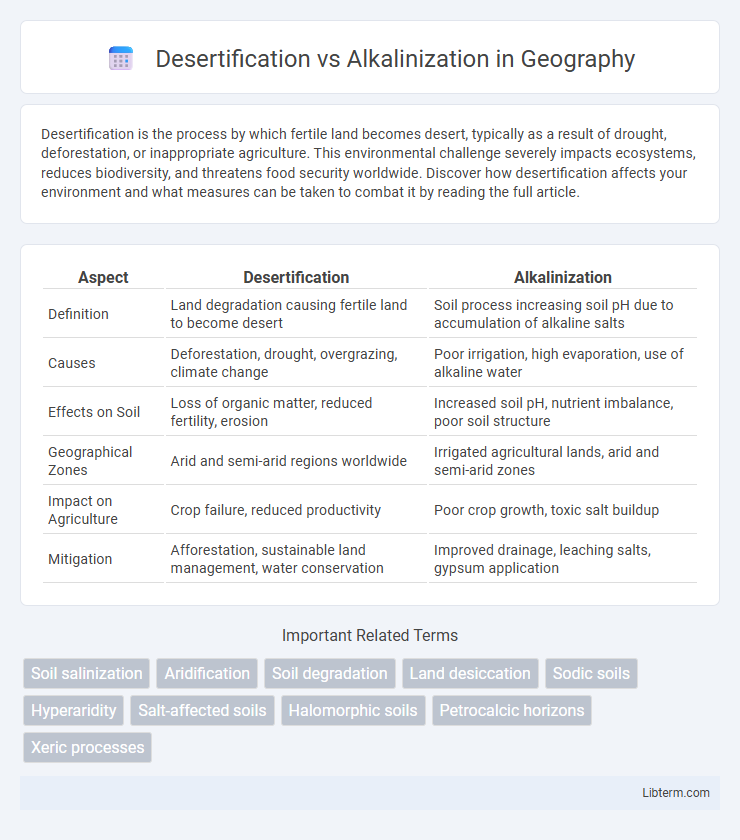Desertification is the process by which fertile land becomes desert, typically as a result of drought, deforestation, or inappropriate agriculture. This environmental challenge severely impacts ecosystems, reduces biodiversity, and threatens food security worldwide. Discover how desertification affects your environment and what measures can be taken to combat it by reading the full article.
Table of Comparison
| Aspect | Desertification | Alkalinization |
|---|---|---|
| Definition | Land degradation causing fertile land to become desert | Soil process increasing soil pH due to accumulation of alkaline salts |
| Causes | Deforestation, drought, overgrazing, climate change | Poor irrigation, high evaporation, use of alkaline water |
| Effects on Soil | Loss of organic matter, reduced fertility, erosion | Increased soil pH, nutrient imbalance, poor soil structure |
| Geographical Zones | Arid and semi-arid regions worldwide | Irrigated agricultural lands, arid and semi-arid zones |
| Impact on Agriculture | Crop failure, reduced productivity | Poor crop growth, toxic salt buildup |
| Mitigation | Afforestation, sustainable land management, water conservation | Improved drainage, leaching salts, gypsum application |
Understanding Desertification: Definition and Causes
Desertification refers to the degradation of land in arid, semi-arid, and dry sub-humid areas, mainly caused by factors such as climate change, deforestation, overgrazing, and unsustainable agricultural practices. This process results in the loss of soil fertility, reduced vegetation cover, and increased vulnerability to drought, severely impacting ecosystems and local livelihoods. Understanding the causes of desertification helps in developing effective land management strategies to combat land degradation and promote sustainable use of natural resources.
What is Alkalinization in Soils?
Alkalinization in soils refers to the process where soil pH rises above 7, resulting in increased alkalinity due to the accumulation of sodium carbonate and bicarbonate salts. This condition often leads to decreased soil fertility by disrupting nutrient availability and reducing microbial activity. Alkalinization is distinct from desertification, which primarily involves land degradation due to water scarcity and vegetation loss.
Key Differences Between Desertification and Alkalinization
Desertification is the process by which fertile land becomes desert mainly due to drought, deforestation, or inappropriate agriculture, leading to soil degradation and loss of vegetation. Alkalinization refers to the increase in soil pH caused by the accumulation of soluble salts, particularly sodium carbonate, which reduces soil fertility and disrupts plant growth. Key differences include desertification's broader environmental impact through ecosystem collapse, while alkalinization specifically alters soil chemistry, each requiring distinct management strategies like erosion control for desertification and salt leaching for alkalinization.
Environmental Impact of Desertification
Desertification causes severe environmental degradation by reducing soil fertility and increasing land degradation, leading to decreased agricultural productivity and loss of biodiversity. It exacerbates water scarcity through diminished soil moisture retention and heightened surface runoff, contributing to ecosystem instability and habitat loss. Alkalinization primarily affects soil pH balance but does not typically result in the extensive degradation or loss of vegetative cover seen in desertification.
Consequences of Soil Alkalinization
Soil alkalinization leads to reduced nutrient availability, impairing plant growth and crop yields by causing deficiencies in essential elements like iron, manganese, and phosphorus. Increased soil pH disrupts microbial activity, hindering organic matter decomposition and nutrient cycling, which further degrades soil fertility. Prolonged alkalinization can result in soil structure deterioration, reduced water infiltration, and increased salinity, exacerbating land degradation and desertification risks.
Factors Driving Desertification Globally
Factors driving desertification globally include prolonged drought, deforestation, unsustainable agricultural practices, and overgrazing, which degrade soil quality and reduce vegetation cover. Climate change exacerbates these processes by increasing temperatures and altering precipitation patterns, leading to soil erosion and loss of arable land. Land mismanagement further accelerates desertification, distinguishing it from alkalinization, which primarily involves soil salinity increases due to irrigation and poor drainage.
Human Activities Linked to Alkalinization
Human activities linked to alkalinization primarily include excessive irrigation with alkaline water, improper drainage systems, and overuse of chemical fertilizers containing sodium compounds. These practices increase soil pH and salt accumulation, leading to reduced soil fertility and crop yields. Unlike desertification, which is driven by land degradation and vegetation loss, alkalinization specifically alters soil chemistry due to anthropogenic inputs.
Prevention and Management Strategies for Desertification
Desertification prevention focuses on sustainable land management techniques such as reforestation, controlled grazing, and soil conservation to restore vegetation cover and enhance soil fertility. Water management strategies like rainwater harvesting and efficient irrigation reduce soil erosion and maintain moisture levels critical for preventing land degradation. Community involvement and policy frameworks promoting land use planning and monitoring systems optimize resource use and support long-term ecosystem resilience.
Solutions to Combat Soil Alkalinization
Soil alkalinization can be effectively combated by applying organic matter such as compost or manure to improve soil structure and nutrient availability. The use of acidifying agents like sulfur or gypsum helps to lower soil pH and reclaim alkaline soils. Implementing proper irrigation management to prevent salt buildup further mitigates alkalinization and enhances soil productivity.
Future Outlook: Addressing Both Soil Degradation Challenges
Desertification and alkalinization pose significant threats to global agriculture, with desertification projected to impact over 40% of the Earth's land surface by 2050, while alkalinization affects approximately 20% of irrigated lands worldwide. Advancements in soil management techniques, such as precision agriculture and biochar applications, offer promising solutions to restore soil fertility and combat salinization. Integrated policies emphasizing sustainable water use, reforestation, and soil amendment can mitigate these degradation processes and promote resilient ecosystems for future food security.
Desertification Infographic

 libterm.com
libterm.com